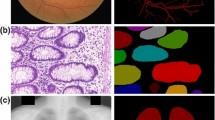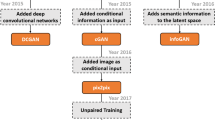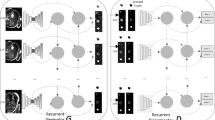Abstract
Several studies have shown the excellent performance of deep learning in image segmentation. Usually, this benefits from a large amount of annotated data. Medical image segmentation is challenging, however, since there is always a scarcity of annotated data. This study constructs a novel deep network for medical image segmentation, referred to as asymmetric U-Net generative adversarial networks with multi-discriminators (AU-MultiGAN). Specifically, the asymmetric U-Net is designed to produce multiple segmentation maps simultaneously and use the dual-dilated blocks in the feature extraction stage only. Further, the multi-discriminator module is embedded into the asymmetric U-Net structure, which can capture the available information of samples sufficiently and thereby promote the information transmission of features. A hybrid loss by the combination of segmentation and discriminator losses is developed, and an adaptive method of selecting the scale factors is devised for this new loss. More importantly, the convergence of the proposed model is proved mathematically. The proposed AU-MultiGAN approach is implemented on some standard medical image benchmarks. Experimental results show that the proposed architecture can be successfully applied to medical image segmentation, and obtain superior performance in comparison with the state-of-the-art baselines.








Similar content being viewed by others
References
Barkana BD, Saricicek I, Yildirim B (2017) Performance analysis of descriptive statistical features in retinal vessel segmentation via fuzzy logic, ANN, SVM, and classifier fusion. Knowledge-Based Syst 118:165–176. https://doi.org/10.1016/j.knosys.2016.11.022
Mitra J, Bourgeat P, Fripp J, Ghose S, Rose S, Salvado O, Connelly A, Campbell B, Palmer S, Sharma G et al (2014) Lesion segmentation from multimodal MRI using random forest following ischemic stroke. Neuroimage 98:324–335. https://doi.org/10.1016/j.neuroimage.2014.04.056
Litjens G, Kooi T, Bejnordi BE, Setio AAA, Ciompi F, Ghafoorian M, Van Der Laak JA, Van Ginneken B, Sánchez CI (2017) A survey on deep learning in medical image analysis. Med Image Anal 42:60–88. https://doi.org/10.1016/j.media.2017.07.005
Yu H, Yang Z, Tan L, Wang Y, Sun W, Sun M, Tang Y (2018) Methods and datasets on semantic segmentation: a review. Neurocomputing 304:82–103. https://doi.org/10.1016/j.neucom.2018.03.037
Cao F, Liu H (2019) Single image super-resolution via multi-scale residual channel attention network. Neurocomputing 358:424–436. https://doi.org/10.1016/j.neucom.2019.05.066
Zhang J, Gu Y, Tang H, Wang X, Kong Y, Chen Y, Shu H, Coatrieux J (2020) Compressed sensing MR image reconstruction via a deep frequency-division network. Neurocomputing 384:346–355. https://doi.org/10.1016/j.neucom.2019.12.011
Cao F, Guo W (2020) Cascaded dual-scale crossover network for hyperspectral image classification. Knowledge-Based Syst 189:105122. https://doi.org/10.1016/j.knosys.2019.105122
Li Z, Dong M, Wen S, Hu X, Zhou P, Zeng Z (2019) Clu-cnns: object detection for medical images. Neurocomputing 350:53–59. https://doi.org/10.1016/j.neucom.2019.04.028
Ronneberger O, Fischer P, Brox T (2015) U-net: convolutional networks for biomedical image segmentation. In: Proceedings of international conference on medical image computing and computer-assisted intervention. Springer, pp 234–241. https://doi.org/10.1007/978-3-319-24574-4_28
Fang L, Wang X, Wang L (2020) Multi-modal medical image segmentation based on vector-valued active contour models. Inf Sci 513:504–518. https://doi.org/10.1016/j.ins.2019.10.051
Long J, Shelhamer E, Darrell T (2015) Fully convolutional networks for semantic segmentation. In: Proceedings of IEEE conference on computer vision and pattern recognition. IEEE, pp 3431–3440. https://doi.org/10.1109/TPAMI.2016.2572683
Badrinarayanan V, Kendall A, Cipolla R (2017) Segnet: a deep convolutional encoder-decoder architecture for image segmentation. IEEE Transactions on Pattern Analysis and Machine Intelligence 39(12):2481–2495. https://doi.org/10.1109/TPAMI.2016.2644615
Wang N, Zhang Z, Xiao J, Cui L (2019) DeepLap: a deep learning based non-specific low back pain symptomatic muscles recognition system. In: 2019 16th annual IEEE international conference on sensing, communication, and networking (SECON). IEEE, pp 1–9. https://doi.org/10.1109/SAHCN.2019.8824868
Simonyan K, Zisserman A (2015) Very deep convolutional networks for large-scale image recognition. In: International conference on learning representations
Roy AG, Siddiqui S, Pölsterl S, Navab N, Wachinger C (2020) ‘Squeeze & excite’ guided few-shot segmentation of volumetric images. Med Image Anal 59:101587. https://doi.org/10.1016/j.media.2019.101587
Cui H, Wei D, Ma K, Gu S, Zheng Y (2020) A unified framework for generalized low-shot medical image segmentation with scarce data. IEEE Trans Med Imaging. https://doi.org/10.1109/TMI.2020.3045775
Ibtehaz N, Rahman MS (2020) MultiResUNet: rethinking the U-Net architecture for multimodal biomedical image segmentation. Neural Networks 121:74–87. https://doi.org/10.1016/j.neunet.2019.08.025
Drozdzal M, Vorontsov E, Chartrand G, Kadoury S, Pal C (2016) The importance of skip connections in biomedical image segmentation: 179–187. https://doi.org/10.1007/978-3-319-46976-8_19
Yu L, Yang X, Chen H, Qin J, Heng PA (2017) Volumetric ConvNets with mixed residual connections for automated prostate segmentation from 3D MR images. In: Proceedings of thirty-first AAAI conference on artificial intelligence. ACM, pp 66–72
Zhou Z, Siddiquee MMR, Tajbakhsh N, Liang J (2018) Unet++: a nested U-Net architecture for medical image segmentation. In: Proceedings of deep learning in medical image analysis and multimodal learning for clinical decision support. Springer, pp 3–11. https://doi.org/10.1007/978-3-030-00889-5_1
Zhuang J (2018) LadderNet: multi-path networks based on U-Net for medical image segmentation. arXiv:1810.07810
Oktay O, Schlemper J, Folgoc LL, Lee M, Heinrich M, Misawa K, Mori K, McDonagh S, Hammerla NY, Kainz B et al (2018) Attention U-Net: learning where to look for the pancreas. In: Proceedings of medical imaging with deep learning
Gu Z, Cheng J, Fu H, Zhou K, Hao H, Zhao Y, Zhang T, Gao S, Liu J (2019) CE-Net: context encoder network for 2D medical image segmentation. IEEE Trans Med Imaging 38 (10):2281–2292. https://doi.org/10.1109/TMI.2019.2903562
Alom MZ, Yakopcic C, Hasan M, Taha TM, Asari VK (2019) Recurrent residual U-Net for medical image segmentation. J Med Imaging 6(1):014006. https://doi.org/10.1117/1.JMI.6.1.014006
Zhang C, Shu H, Yang G, Li F, Wen Y, Zhang Q, Dillenseger JL, Coatrieux JL (2020) HIFUNet: multi-class segmentation of uterine regions from MR images using global convolutional networks for HIFU surgery planning. IEEE Trans Med Imaging 39(11):3309–3320. https://doi.org/10.1109/TMI.2020.2991266
Luc P, Couprie C, Chintala S, Verbeek J (2016) Semantic segmentation using adversarial networks. In: NIPS workshop on adversarial training
Xie H, Lei H, Zeng X, He Y, Chen G, Elazab A, Yue G, Wang J, Zhang G, Lei B (2020) Amd-gan: attention encoder and multi-branch structure based generative adversarial networks for fundus disease detection from scanning laser ophthalmoscopy images. Neural Networks 132:477–490. https://doi.org/10.1016/j.neunet.2020.09.005
Dong X, Lei Y, Wang T, Thomas M, Tang L, Curran WJ, Liu T, Yang X (2019) Automatic multiorgan segmentation in thorax CT images using U-net-GAN. Medical Physics 46(5):2157–2168. https://doi.org/10.1002/mp.13458
Negi A, Raj ANJ, Nersisson R, Zhuang Z, Murugappan M (2020) RDA-UNET-WGAN: an accurate breast ultrasound lesion segmentation using wasserstein generative adversarial networks. Arabian Journal for Science and Engineering 45:6399– 6410
Lin TY, Goyal P, Girshick R, He K, Dollár P (2017) Focal loss for dense object detection. In: Proceedings of ieee international conference on computer vision, pp 2980–2988. https://doi.org/10.1109/iccv.2017.324
Shi W, Caballero J, Huszár F, Totz J, Aitken AP, Bishop R, Rueckert D, Wang Z (2016) Real-time single image and video super-resolution using an efficient sub-pixel convolutional neural network. In: Proceedings of IEEE conference on computer vision and pattern recognition. pp 1874–1883. https://doi.org/10.1109/CVPR.2016.207
De Haan L, Ferreira A (2007) Extreme value theory: an introduction. Springer Science & Business Media
Coelho LP, Shariff A, Murphy RF (2009) Nuclear segmentation in microscope cell images: A hand-segmented dataset and comparison of algorithms. In: Proceedings of IEEE international symposium on biomedical imaging: from nano to macro. IEEE, pp 518–521. https://doi.org/10.1109/ISBI.2009.5193098
Arganda-Carreras I, Turaga SC, Berger DR, Cireşan D, Giusti A, Gambardella LM, Schmidhuber J, Laptev D, Dwivedi S, Buhmann JM et al (2015) Crowdsourcing the creation of image segmentation algorithms for connectomics. Front Neuroanat 9:142. https://doi.org/10.3389/fnana.2015.00142
Cardona A, Saalfeld S, Preibisch S, Schmid B, Cheng A, Pulokas J, Tomancak P, Hartenstein V (2010) An integrated micro-and macroarchitectural analysis of the Drosophila brain by computer-assisted serial section electron microscopy. PLoS Biol 8(10):1000502. https://doi.org/10.1371/journal.pbio.1000502
Lu Z, Carneiro G, Bradley AP, Ushizima D, Nosrati MS, Bianchi AG, Carneiro CM, Hamarneh G (2016) Evaluation of three algorithms for the segmentation of overlapping cervical cells. IEEE J Biomed Health Inform 21(2):441–450. https://doi.org/10.1109/JBHI.2016.2519686
Lu Z, Carneiro G, Bradley AP (2015) An improved joint optimization of multiple level set functions for the segmentation of overlapping cervical cells. IEEE Trans Image Process 24(4):1261–1272. https://doi.org/10.1109/TIP.2015.2389619
Staal JJ, Abramoff M, Niemeijer M, Viergever M, van Ginneken B (2004) Drive: digital retinal images for vessel extraction. IEEE Trans Med Imaging 23(4):501–509
Codella NC, Gutman D, Celebi ME, Helba B, Marchetti MA, Dusza SW, Kalloo A, Liopyris K, Mishra N, Kittler H et al (2018) Skin lesion analysis toward melanoma detection: A challenge at the 2017 international symposium on biomedical imaging (ISBI), hosted by the international skin imaging collaboration (ISIC). In: Proceedings of IEEE 15th international symposium on biomedical imaging, pp 168–172. https://doi.org/10.1109/ISBI.2018.8363547
Tschandl P, Rosendahl C, Kittler H (2018) The ham10000 dataset, a large collection of multi-source dermatoscopic images of common pigmented skin lesions. Scientific Data 5(1):1–9. https://doi.org/10.1038/sdata.2018.161
Bernal J, Sánchez FJ, Fernández-Esparrach G, Gil D, Rodríguez C, Vilariño F (2015) Wm-dova maps for accurate polyp highlighting in colonoscopy: Validation vs. saliency maps from physicians. Computerized Medical Imaging and Graphics 43:99–111. https://doi.org/10.1016/j.compmedimag.2015.02.007
Fausto M, Nassir N, Seyed-Ahmad A (2016) V-Net: fully convolutional neural networks for volumetric medical image segmentation. In: Proceedings of 2016 fourth international conference on 3D vision. IEEE, pp 565–571. https://doi.org/10.1109/3DV.2016.79
Hassan T, Akram MU, Werghi N, Nazir N (2020) Rag-fw: A hybrid convolutional framework for the automated extraction of retinal lesions and lesion-influenced grading of human retinal pathology. IEEE J Biomed Health Inform 24(99):1–1. https://doi.org/10.36227/techrxiv.11877879.v1
Shu J, Xie Q, Yi L, Zhao Q, Zhou S, Xu Z, Meng D (2019) Meta-weight-net: learning an explicit mapping for sample weighting. In: Advances in neural information processing systems, pp 1919–1930
Boyd S, Boyd SP, Vandenberghe L (2004) Convex optimization. Cambridge University Press, Cambridge
Acknowledgments
This work was supported by the National Natural Science Foundation of China under grant 61672477, and the Zhejiang Provincial Natural Science Foundation of China under grant LZ20F030001.
Author information
Authors and Affiliations
Corresponding author
Additional information
Publisher’s note
Springer Nature remains neutral with regard to jurisdictional claims in published maps and institutional affiliations.
Appendix A
Appendix A
1.1 A.1 Proof of Lemma 1
For a given generator Gi, the training criterion for the sub-discriminator Di(i = 1, 2,…,k) is to minimize the discriminator loss, LGAN(Gi,Di). Let
By the formula in (22), the optimisation problem of the sub-discriminator can be transformed into a least squares problem:
It achieves the minimum at \(\frac {p_{_{\boldsymbol {Y}_{i}}}(\boldsymbol {Y}_{i})}{p_{_{\boldsymbol {Y}_{i}}}(\boldsymbol {Y}_{i})+p_{g_{i}}(\boldsymbol {Y}_{i})} (i=1,2,\ldots ,k)\) in [0, 1]. This completes the proof.
1.2 A.2 Proof of Lemma 2
For all i(i = 1, 2,…,k), if the relation \(p_{g_{i}}=p_{_{\boldsymbol {Y}_{i}}}\) is satisfied, then \(D_{i}^{*}=\frac {1}{2}\) is calculated by (16). Hence,
To see that \(\frac {1}{4}\) is the best possible value of \(\underset {D_{i}}{\min \limits } L_{\text {GAN}}(G_{i},D_{i})\), reached only for \(p_{g_{i}}=p_{_{\boldsymbol {Y}_{i}}}\), we observe
where the relationship between \(D_{i}^{*2}(\boldsymbol {Y}_{i})\), the label distribution \(p_{_{\boldsymbol {Y}_{i}}}\) and the generated segmentation distribution \(p_{g_{i}}\) are obtained in Lemma 1. Here, we introduce this relationship into the above formula.
where χ2 is the Pearson χ2 divergence and \(\chi ^{2}(p_{_{\boldsymbol {Y}_{i}}}\) \(+p_{g_{i}}\|2p_{_{\boldsymbol {Y}_{i}}})\) denotes the simplified representation of \({\int \limits }_{\boldsymbol {Y}_{i}} \left [\frac {(2p_{_{\boldsymbol {Y}_{i}}}(\boldsymbol {Y}_{i}) - (p_{_{\boldsymbol {Y}_{i}}}(\boldsymbol {Y}_{i}) + p_{g_{i}}(\boldsymbol {Y}_{i})))^{2}}{p_{_{\boldsymbol {Y}_{i}}} (\boldsymbol {Y}_{i}) + p_{g_{i}}(\boldsymbol {Y}_{i})}\right ]d\boldsymbol {Y}_{i}\). Thus, the results of (26) achieve the value \(\frac {1}{4}\) when \(p_{_{\boldsymbol {Y}_{i}}}\) and \(p_{g_{i}}\) are equal. We have shown that \(L_{\text {GAN}}=\frac {1}{4}\) and that the only solution is \(p_{g_{i}}=p_{_{\boldsymbol {Y}_{i}}}\). Thus, the asymmetric U-Net can perfectly replicate the distribution of the real segmented image. This completes the proof.
1.3 A.3 Proof of Theorem 1
Consider \(L_{\text {GAN}}(G_{i},D_{i})=\mathrm {V}(p_{g_{i}},D_{i})\) as a function of \(p_{g_{i}}\), as done in the above criterion (17), in which \(\mathrm {V}(p_{g_{i}},D_{i})\) is the criterion. Note that \(\mathrm {V}(p_{g_{i}},D_{i})\) is convex on \(p_{g_{i}}\). The inf-derivatives of an infimum of convex functions are the derivative of the function at the point where the minimum is attained. This is equivalent to computing a gradient descent update for \(p_{g_{i}}\) at the optimal Di, given the corresponding Gi. From [45], \(\inf _{D_{i}}L_{\text {GAN}}(G_{i},D_{i})\) is convex on \(p_{g_{i}}\). Moreover, \(\inf _{D_{i}}L_{\text {GAN}}(G_{i},D_{i})\) takes the value \(\frac {1}{4}\) as proven in Lemma 2; therefore, with sufficiently small updates of \(p_{g_{i}}\), \(p_{g_{i}}\) converges to \(p_{_{\boldsymbol {Y}_{i}}}(i=1,2,\ldots ,k)\). This completes the proof.
Rights and permissions
About this article
Cite this article
Wang, Y., Ye, H. & Cao, F. A novel multi-discriminator deep network for image segmentation. Appl Intell 52, 1092–1109 (2022). https://doi.org/10.1007/s10489-021-02427-x
Accepted:
Published:
Issue Date:
DOI: https://doi.org/10.1007/s10489-021-02427-x




